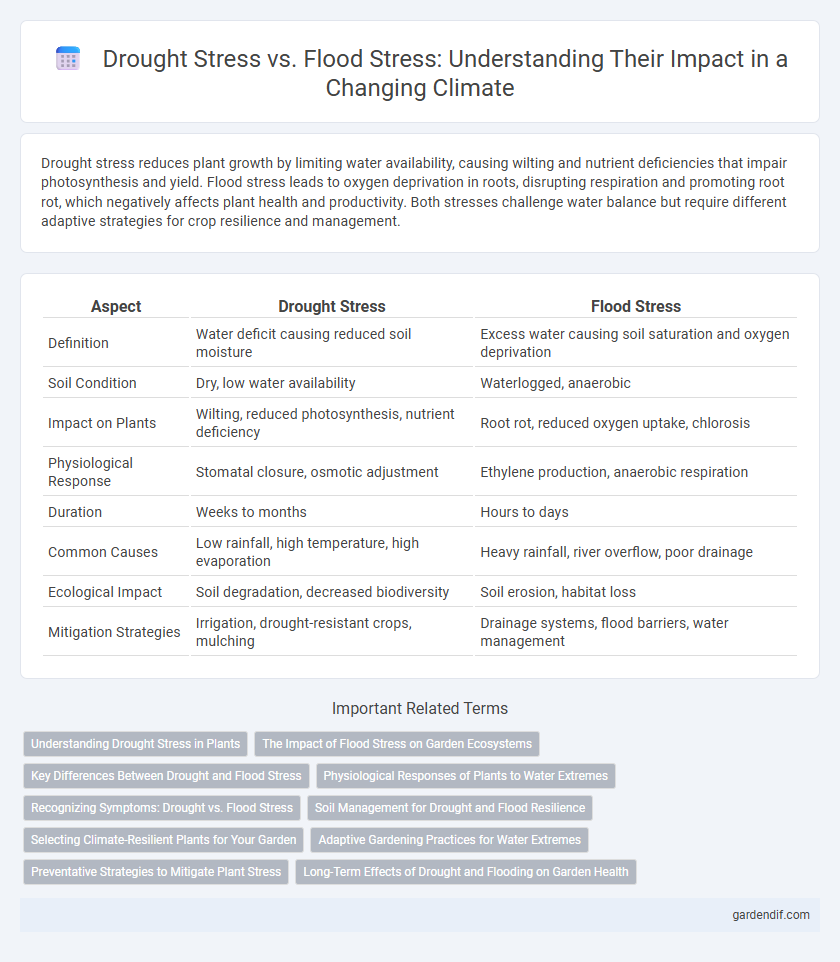
Drought stress vs Flood stress Illustration
Drought stress reduces plant growth by limiting water availability, causing wilting and nutrient deficiencies that impair photosynthesis and yield. Flood stress leads to oxygen deprivation in roots, disrupting respiration and promoting root rot, which negatively affects plant health and productivity. Both stresses challenge water balance but require different adaptive strategies for crop resilience and management.
Table of Comparison
| Aspect | Drought Stress | Flood Stress |
|---|---|---|
| Definition | Water deficit causing reduced soil moisture | Excess water causing soil saturation and oxygen deprivation |
| Soil Condition | Dry, low water availability | Waterlogged, anaerobic |
| Impact on Plants | Wilting, reduced photosynthesis, nutrient deficiency | Root rot, reduced oxygen uptake, chlorosis |
| Physiological Response | Stomatal closure, osmotic adjustment | Ethylene production, anaerobic respiration |
| Duration | Weeks to months | Hours to days |
| Common Causes | Low rainfall, high temperature, high evaporation | Heavy rainfall, river overflow, poor drainage |
| Ecological Impact | Soil degradation, decreased biodiversity | Soil erosion, habitat loss |
| Mitigation Strategies | Irrigation, drought-resistant crops, mulching | Drainage systems, flood barriers, water management |
Understanding Drought Stress in Plants
Drought stress in plants occurs when water availability falls below the optimal level, impairing physiological processes such as photosynthesis, nutrient uptake, and growth. It triggers stomatal closure to reduce water loss, but prolonged stress leads to reduced cellular turgor, oxidative damage, and impaired metabolic functions. Understanding the molecular and biochemical responses of plants to drought stress is critical for developing drought-resistant crop varieties and ensuring sustainable agriculture.
The Impact of Flood Stress on Garden Ecosystems
Flood stress in garden ecosystems disrupts soil aeration, causing root suffocation and increasing susceptibility to root rot pathogens. Excess water alters nutrient availability by leaching essential minerals like nitrogen and potassium, leading to nutrient deficiencies that impair plant growth. Prolonged flooding fosters anaerobic soil conditions, reducing microbial diversity crucial for nutrient cycling and overall soil health.
Key Differences Between Drought and Flood Stress
Drought stress primarily limits plant water availability, causing reduced photosynthesis, stunted growth, and wilting due to insufficient soil moisture. Flood stress results from excess water, leading to oxygen deprivation in roots, root rot, and nutrient leaching, which impair plant respiration and nutrient uptake. Key differences include water availability, soil oxygen levels, and the distinct physiological responses triggered by water deficit in drought versus water saturation in floods.
Physiological Responses of Plants to Water Extremes
Drought stress triggers stomatal closure, reducing photosynthesis and leading to decreased leaf expansion and growth due to limited water availability. Flood stress induces root hypoxia, impairing nutrient uptake and causing root decay, while promoting the formation of aerenchyma to facilitate oxygen transport. Both conditions activate the production of stress hormones such as abscisic acid and ethylene, which regulate adaptive responses to maintain cellular homeostasis.
Recognizing Symptoms: Drought vs. Flood Stress
Drought stress symptoms include wilting, yellowing, and curling of leaves due to limited water availability, leading to reduced photosynthesis and stunted growth. Flood stress causes root oxygen deprivation, resulting in chlorosis, leaf drop, and root rot, impairing nutrient uptake and causing plant decline. Accurate identification of these stress indicators supports targeted irrigation management and crop resilience strategies.
Soil Management for Drought and Flood Resilience
Effective soil management practices enhance resilience to both drought and flood stresses by improving soil structure and water retention capacity. Techniques such as organic matter incorporation, mulching, and conservation tillage increase soil moisture retention during droughts, while contour farming and the construction of raised beds help mitigate flood impacts by promoting better drainage and reducing waterlogging. Optimizing soil health through these methods supports crop productivity and stability under varying climatic stress conditions.
Selecting Climate-Resilient Plants for Your Garden
Drought stress and flood stress impose distinct challenges on plant survival, with drought causing water scarcity and impaired photosynthesis, while flood stress leads to oxygen deprivation and root rot. Selecting climate-resilient plants involves choosing species with enhanced tolerance to these extremes, such as succulents or deep-rooted perennials for drought, and wetland-adapted species like willows or bald cypress for flood-prone areas. Incorporating native plants known for adaptability to local climate variability strengthens garden resilience against both drought and flooding conditions.
Adaptive Gardening Practices for Water Extremes
Adaptive gardening practices for water extremes involve selecting drought-resistant plant species and implementing efficient irrigation methods such as drip irrigation to mitigate drought stress. For flood stress, gardeners prioritize raised beds and improved soil drainage to prevent waterlogging and root damage. Incorporating mulch helps retain moisture during dry periods and enhances soil aeration during floods, supporting plant resilience under varying climate conditions.
Preventative Strategies to Mitigate Plant Stress
Implementing efficient irrigation management and soil moisture monitoring helps prevent drought stress by maintaining optimal hydration levels for crops. Flood stress can be mitigated with improved drainage systems, raised bed planting, and selection of flood-tolerant crop varieties to reduce root oxygen deprivation. Integrating organic mulches and cover crops enhances soil structure and water retention, providing resilience against both drought and flood stress in agricultural systems.
Long-Term Effects of Drought and Flooding on Garden Health
Prolonged drought stress reduces soil moisture, leading to impaired root growth, decreased nutrient uptake, and increased vulnerability to pests and diseases, ultimately weakening overall garden health. Conversely, chronic flooding causes root oxygen deprivation, promotes root rot, and disrupts soil microbial balance, resulting in poor plant development and increased susceptibility to pathogens. Both drought and flood stress alter soil structure and nutrient availability, undermining plant resilience and long-term garden productivity.
Drought stress vs Flood stress Infographic

 gardendif.com
gardendif.com